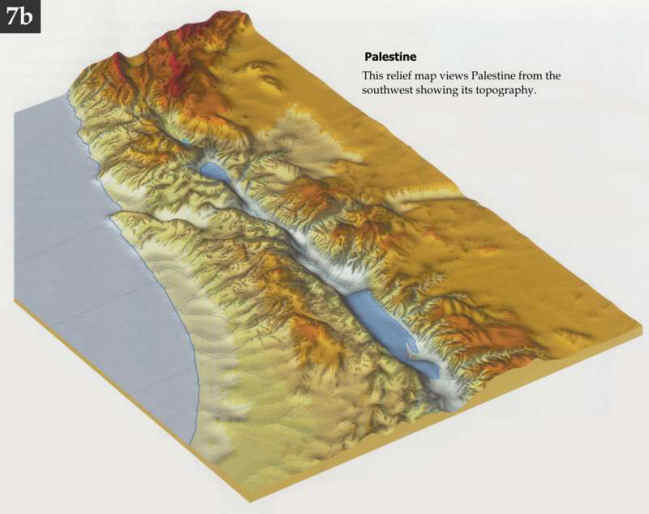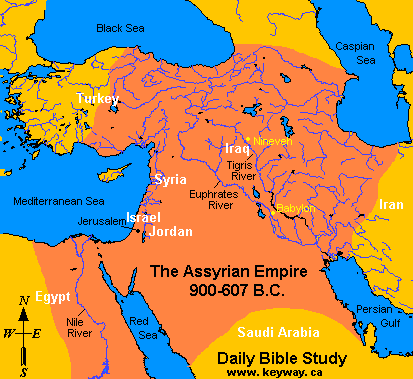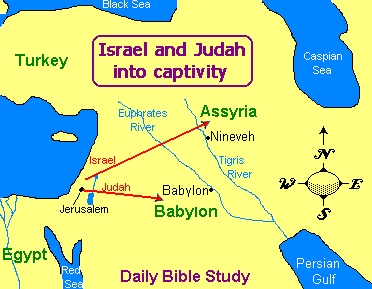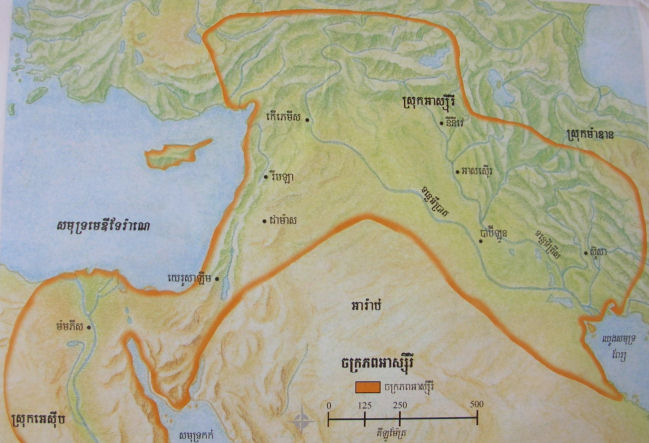+ Blue Letter Bible/KJV + 개역한글 성경구절


▶ 앗수르(Assyria, Asshur)
북부 이라크 티그리스 강 기슭
고대 메소보다미아 왕국들 중의 하나로 남방 왕국인 바벨로니아가 바그다드와 페르샤만 사이의 평지를 차지한 반면에 앗수르는 대체로 서쪽으로 평지를 차지한 반면에 앗수르는 대체로 서쪽으로 시리아 사막과 남쪽으로 베벨로니아와 북쪽과 동쪽으로 아르메니아 및 페르샤 산과 접경을 이루었다.
앗수르는 셈의 아들로(대상01:17) 족장 시대 이전에 티그리스, 유프라테스 강 유역의 바벨론 북쪽에 고대 왕국을 세우고 중동 지방에서 정치적인 활약을 하고 있었다. 다행히도 앗수르의 세력은 이스라엘 역사상 가장 유능한 왕이었던 다윗 왕 시대에 극도로 쇠약해 있었다. 그 후 앗수르는 수도 니느웨를 중심으로 점차 그 세력이 강해지기 시작하였고 특히 북 왕국 이스라엘에 대해서는 막강한 영향력을 행사하였다.
물론 그 세력이 다소 약화되었던 여로보암 2세와 웃시야 왕 때에 이스라엘은 어느 정도의 힘을 발휘하여 자유를 찾아 국가로서의 면모를 갖추기도 하였지만 앗수르 제국의 재건을 시도한 디글랏 빌레셋 3세와 뒤를 이은 살만에셀 5세의 공격으로, 결국 이스라엘은 멸망하여 그의 속국이 되었고 그들의 포로가 되고 말았다(왕하17:6).
앗수르의 세력은 주전 8세기에 황금 시대를 이루었으나 그 후 주전 612년에 신 바벨론에 의한 수도 니느웨의 함락과 동시에 멸망되었다


The Assyrian Empire / Assuerus
--->▶ Esther
▶ Asshur (민24:22, (민24:24, (시083:8, (겔27:23
Num 24:22, Num 24:24, Ps 83:8, Ezek 27:23
lt=36.359&ln=43.152
▶ 앗수르 Assyria. [Assy'ria]
The great kingdom of Assyria was situated near the river Tigris, having Armenia on the North, Mount Zagros and Media on the east, Babylonia on the south, Syria and the Syrian desert on the west; but its boundaries were doubtless not always the same. Nineveh became its capital. The first allusion to Assyria is found in Gen. 2:14, where we read that one of the rivers of Paradise went "toward the east of Assyria," or "went eastward to Assyria," margin.
(창02:14 세째 강의 이름은 힛데겔이라 앗수르 동편으로 흐르며 네째 강은 유브라데더라
The name of Assyria appears to have arisen from its first capital, Asshur (now called Kalah Sherghat) on the Tigris. Apparently a monarchy was established there by some from Babylonia, and there were several kings before SHALMANESER I. (about B.C. 1300), whose family kept the throne for six generations until TIGLATH-PILESER I. (about B.C. 1130), who may be said to be the founder of the first Assyrian Empire. He beautified Nineveh and carried his arms in various directions. After him the kingdom became feeble until RIMMON-NIRARI II., B.C. 911, but his victorious career was excelled by his grandson, the great ASSUR-NATSIR-PAL, B.C. 883, who made conquests over the Phoenicians and the 'Kaldu' (Chaldeans).
SHALMANESER II succeeded, B.C. 858. He carried his arms still farther. We have his conquests told by himself on three monuments in the British Museum, one of which is known as the Black Obelisk. If the names are correctly interpreted he mentions as allied against him Benhadad king of Syria and Ahab king of Israel. These were defeated at the battle of Karkar, B.C. 853. Hazael of Damascus was also defeated; and from Yahua, the son of Khumri, that is, Jehu, whom he incorrectly calls son of Omri, king of Israel, he received tribute; but of this scripture says nothing.
The next king who invaded Syria was RIMMON-NIRARI III B.C. 810. He extended his victories to what he calls, 'the shore of the sea of the setting sun,' which is doubtless the Mediterranean, and imposed tribute on the Phoenicians, Israelites, Edomites, Philistines, and the king of Damascus. After this king the power of Assyria waned for a time.
The next king of note was TIGLATH -PILESER II. or III. B.C. 745, who is considered to have founded the second Assyrian kingdom. He consolidated the various dependencies, turbulent populations were removed, and the empire was divided into provinces, each of which paid a fixed annual tribute. In his inscriptions occur the names of Jehoahaz (Ahaz) of Judah; Pekah, and Hoshea of Israel; Reson (Resin) of Damascus; and Hiram of Tyre. The name of Merodach-baladan is also found. Hamath was taken and then all Palestine was at his feet. He attacked those on the east of the Jordan, and carried away the Reubenites, the Gadites, and the half-tribe of Manasseh. 1 Chr. 5:26. Ahaz sought his alliance against Rezin the king of Damascus. Rezin was slain and the city taken; and there Ahaz met the king of Assyria. 2 Kings 16:1-10; 2 Chr. 28:16-21. He also made himself master of Babylonia; but this afterwards gained its independence under Merodach-baladan. Some Assyrian scholars take Tiglath-pileser (whose name appears to have been Pulu) to be the same person as the Pul mentioned in the Bible; but this does not at all agree with the dates of scripture, and in 1 Chr. 5:26 the names of Pul and Tiglath-pileser are mentioned as of two persons. See PUL.
(대상05:26 그러므로 이스라엘 하나님이 앗수르 왕 불의 마음을 일으키시며 앗수르 왕 디글랏 빌레셀의 마음을 일으키시매 곧 르우벤과 갓과 므낫세 반 지파를 사로잡아 할라와 하볼과 하라와 고산 하숫가에 옮긴지라 저희가 오늘날까지 거기 있으니라
(왕하16:1-10; 유다왕 아하스
(대하28:16-21. 아하스가 앗수르에 도움을 구하다
In B.C. 727 SHALMANESER IV. succeeded to the throne. Hoshea king of Israel was subject to him; but on being found in treaty with the king of Egypt, Samaria was besieged. 2 Kings 17:3-5.
(왕하17:3-5 3 앗수르 왕 살만에셀이 올라와서 호세아를 친 고로 호세아가 신복하여 조공을 드리더니 4 저가 애굽 왕 소에게 사자들을 보내고 해마다 하던 대로 앗수르 왕에게 조공을 드리지 아니하매 앗수르 왕이 호세아의 배반함을 보고 저를 옥에 금고하여 두고 5 올라와서 그 온 땅에 두루 다니고 사마리아로 올라와서 삼년을 에워쌌더라
In B.C. 722 SARGON succeeded, and apparently it was he who captured Samaria. An inscription of his at Khorsabad reads, "I besieged the city of Samaria and carried away 27,280 men who dwelt there into captivity, and took fifty chariots from among them, and ordered the rest to be taken. I set my judges over them, and imposed upon them the tribute of the former kings." He also placed colonists in Samaria, but it is supposed by the names of the places mentioned from which these were sent, that this was not done immediately. Sargon captured Carchemish, punished the king of Syria, flayed alive the king of Hamath, and then successfully overcame So or Sabako. Sargon is mentioned in Isa. 20:1 as sending his general to Ashdod, who took it. An inscription also mentions the fall of the city. Sargon defeated Merodach-baladan in Babylonia, but was assassinated in B.C. 705. He was called SHARRU-KENU, that is, 'faithful king.'
(사20:1 앗수르 왕 사르곤이 군대장관을 아스돗으로 보내매 그가 와서 아스돗을 쳐서 취하던 해
SENNACHERIB succeeded Sargon his father, B.C. 705. Hezekiah had been tributary; but on his revolting Sennacherib took the fenced cities of Judah, and then Hezekiah sent him the treasures of his own house and the house of the Lord. Still Jerusalem was attacked, and profane speeches made against the God of Israel. Hezekiah humbled himself before God, and the angel of the Lord smote of the Assyrians 185,000. Sennacherib returned to his land and was eventually murdered by two of his sons. 2 Kings 18:13 - 19:37. In Sennacherib's own account he says, "Hezekiah himself I shut up like a bird in a cage in Jerusalem, his royal city . . . . in addition to his former tribute and yearly gifts I added other tribute and the homage due to my majesty, and I laid it upon them." The above date would clash with the date of Hezekiah, but it is probable that Sennacherib was co-regent with his father some nine years before he reigned alone.
(왕하18:13 - 19:37. 앗수르의 위협과 산헤립의 죽음
A tablet shows Sennacherib sitting on a throne to receive the spoils of the city of Lachish. It is supposed he lived 20 years after he left Palestine before he was assassinated. He says nothing of the loss of his army, and perhaps never recovered the shock.
ESAR-HADDON succeeded, B.C. 681. He is said to have reigned from the Euphrates to the Nile. He also conquered Egypt, and divided it into 20 provinces, governed by Assyrians. According to an inscription he claimed the sovereignty of Babylon, and held his court there. This accounts for him, as king of Assyria, carrying Manasseh captive to Babylon. 2 Chr. 33:11. He is mentioned also in Ezra 4:2 as having sent the colonists into Judaea. After reigning about 10 years he associated with him his son the noted ASSUR-BANI-PAL. Egypt was again conquered. He gathered a famous library at Kouyunjik, the terra cotta tablets of which have been preserved. Assur-bani-pal died about B.C. 626. The glory of the Assyrian kingdom was permanently departing, and about B.C. 606 Nineveh was taken and destroyed. Nahum 1 - 3.
(대하33:11 여호와께서 앗수르 왕의 군대 장관들로 와서 치게 하시매 저희가 므낫세를 사로잡고 쇠사슬로 결박하여 바벨론으로 끌어 간지라
(스04:2 스룹바벨과 족장들에게 나아와 이르되 우리로 너희와 함께 건축하게 하라 우리도 너희 같이 너희 하나님을 구하노라 앗수르 왕 에살핫돈이 우리를 이리로 오게한 날부터 우리가 하나님께 제사를 드리노라
(나01: 니느웨에 대한 여호와의 진노
(나02: 니느웨의 멸망1
(나03: 니느웨의 멸망2
There are many monuments and inscriptions on tablets which the learned are deciphering; but the difficulties of distinguishing the proper names on the Assyrian monuments are shown by M. Joachim Menant, who gives as an instance one sign which may be read kal, rip, dan, or lip, being one of the signs called 'polyphones.'
The following list of kings is from Rawlinson, Sayce, and other Assyrian scholars. The early dates are uncertain and several of the later dates do not agree with the usual chronology of scripture.
ASSYRIAN KINGS. B.C.
Shalmaneser I. 1300
Tiglath-Adar I., his son 1280
Bel-kudur-utsur (Belchadrezzar) his son 1260
Assur-narara and Nebo-dan 1240
Adar-pal-esar (Adar-pileser) 1220
Assur-dan I., his son 1200
Mutaggil-Nebo, his son 1180
Assur-ris-ilim, his son 1160
Tiglath-pileser I., his son 1140
Assur-bel-kala, his son 1110
Samas-Rimmon I., his brother 1090
Assur-rab-buri ?
Assur-zalmati ?
Assur-dan II 930
Rimmon-nirari II., his son 911
Tiglath-Adar II., his son 889
Assur-natsir-pal, his son 883
Shalmaneser II., his son 858
Samas-Rimmon II., his son 823
Rimmon-nirari III., his son 810
Shalmaneser III. 781
Assur-dan III. 771
Assur-nirari 753
Pulu, usurper, Tiglath-pileser II. or III 745
Ulula (Elulaeos) of Tinu, usurper, Shalmaneser IV. 727
Sargon, usurper 722
Sennacherib of Khabigal, his son 705
Esar-haddon, his son 681
Assur-bani-pal (Sardanapalus) his son 668
Assur-etil-ili-yukinni, his son ? 626
Esar-haddon II. (Sarakos) ?
Fall of Nineveh? 606
The Assyrians were idolaters: from the inscriptions the names of hundreds of gods can be gathered.
The Assyrian language was a branch of the Semitic, and came from the Accadian. It was written in Cuneiform or wedge-shaped characters.
Assyria was used by God as His rod to punish His guilty people Israel, and then, as in other instances, the rod itself, for its pride and wickedness, had to bear God's judgement. See Isa. 10:5-19; Isa. 14:25; Ezek. 31:3-17; Nahum 3:18, 19; Zeph. 2:13. Some of the passages that speak of the kings of Assyria are prophetic, and refer to the still future, when as 'kings of the north' they will again have to do with Israel and will be judged of God. The indignation against Israel ceases in the destruction of the Assyrian: see Isa. 10:12; Isa. 14:25; Isa. 30:27-33. One remarkable passage speaks of Assyria with Egypt and Israel as being brought into blessing, Isa. 19:23-25, "Whom the Lord of hosts shall bless, saying, Blessed be Egypt my people, and Assyria the work of my hands, and Israel mine inheritance." We thus see that the Assyrians have a large place in scripture both in the past and in the future, doubtless because they have had, and will yet have, to do with Jehovah's earthly people, "the Israel of God." The Assyrian is the over-flowing scourge of God's anger because of Israel's connection with idolatry.
(사10:5-19; 하나님의 도구인 앗수르
(사14:25 내가 앗수르 사람을 나의 땅에서 파하며 나의 산에서 발아래 밟으리니 그 때에 그의 멍에가 이스라엘에게서 떠나고 그의 짐이 그들의 어깨에서 벗어질 것이라
(겔31:3-17; 한때 백향목 같았던 애굽
(나03:18, 19; 18 앗수르 왕이여 네 목자가 자고 네 귀족은 누워 쉬며 네 백성은 산들에 흩어지나 그들을 모을 사람이 없도다 19 너의 다친 것은 고칠 수 없고 네 상처는 중하도다 네 소식을 듣는 자가 다 너를 인하여 손뼉을 치나니 이는 네 악행을 늘 받지 않은 자가 없음이 아니냐
(습02:13 여호와가 북방을 향하여 손을 펴서 앗수르를 멸하며 니느웨로 황무케 하여 사막 같이 메마르게 하리니
(사10:12 이러므로 주 내가 나의 일을 시온산과 예루살렘에 다 행한 후에 앗수르 왕의 완악한 마음의 열매와 높은 눈의 자랑을 벌하리라
(사14:25; 내가 앗수르 사람을 나의 땅에서 파하며 나의 산에서 발아래 밟으리니 그 때에 그의 멍에가 이스라엘에게서 떠나고 그의 짐이 그들의 어깨에서 벗어질 것이라
(사30:27-33. 여호와께서 앗수를 치시리라
(사19:23-25, 23 그 날에 애굽에서 앗수르로 통하는 대로가 있어 앗수르 사람은 애굽으로 가겠고 애굽 사람은 앗수르로 갈 것이며 애굽 사람이 앗수르 사람과 함께 경배하리라 24 그 날에 이스라엘이 애굽과 앗수르로 더불어 셋이 세계 중에 복이 되리니 25 이는 만군의 여호와께서 복을 주어 가라사대 나의 백성 애굽이여, 나의 손으로 지은 앗수르여, 나의 산업 이스라엘이여, 복이 있을 지어다 하실 것임이니라
--- Morrish Bible Dictionary
▶ Assyria (창02:14, (창10:11, (창25:18, (왕하15:19, (왕하16:7, (왕하17:3, (왕하18:7, (왕하19:4,(왕하20:6, (왕하23:29, (대상05:6, (대하28:16, (대하30:6, (대하32:1,(대하33:11, (스04:2, (스06:22, (느09:32, (사07:17, (사08:4, (사10:5, (사11:11, (사19:23, (사20:1, (사23:13, (사27:13, (사36:1, (사37:4, (사38:6, (렘02:18, (렘50:17, (애05:6, (겔23:7, (겔31:3, (겔32:22, (호05:13, (호07:11, (호08:9, (호09:3, (호10:6, (호11:5, (호12:1, (호14:3, (미05:6, (미07:12, (나03:18, (습02:13, (슥10:10
lt=36.359&ln=43.152
개역한글KHRV( 120일1독, 1년1독, 권별, 성경통독 )
STUDY - 구절(WESLEY), 단락(MATTHEW), 읽기(Wayne),
Dictionary - Chapter, OT구약, NT신약, 테마별,
|
1창세기[Genesis] 2출애굽기[Exodus] 3레위기[Leviticus] 4민수기[Numbers] 5신명기[Deuteronomy] 6여호수아[Joshua] 7사사기[Judges] 8룻기[Ruth] 9사무엘상[I Samuel] 10사무엘하[II Samuel] 11열왕기상[I Kings] 12열왕기하[II Kings] 13역대상[I Chronicles] 14역대하[II Chronicles] 15에스라[Ezra] 16느헤미아[Nehemiah] 17에스더[Esther] 18욥기[Job] 19시편[Psalms] 20잠언[Proverbs] 21전도서[Ecclesiastes] 22아가[Song of Solomon] 23이사야[Isaiah] 24예레미야[Jeremiah] 5예레미아애가[Lamentations] 26에스겔[Ezekiel] 27다니엘[Daniel] 28호세아[Hosea] 29요엘[Joel] 30아모스[Amos] 31오바댜[Obadiah] 32요나[Jonah] 33미가[Micah] 34나훔[Nahum] 35하박국[Habakkuk] 36스바냐[Zephaniah] 37학개[Haggai] 38스가랴[Zechariah] 39말라기[Malachi] 40마태복음[Matthew] 41마가복음[Mark] 42누가복음[Luke] 43요한복음[John] 44사도행전[Acts] 45로마서[Romans] 46고린도전서[I Corinthians] 47고린도후서[II Corinthians] 48갈라디아서[Galatians] 49에베소서[Ephesians] 50빌립보서[Philippians] 51골로새서[Colossians] 52데살로니가전서[I Thessalonian] 53데살로니가후서[2 Thessalonian] 54디모데전서[I Timothy] 55디모데후서[II Timothy] 56디도서[Titus] 57빌레몬서[Philemon] 58히브리서[Hebrews] 59야고보서[James] 60베드로전서[I Peter] 61베드로후서[II Peter] 62요한일서[I John] 63요한이서[II John] 64요한삼서[III John] 65유다서[Jude] 66요한계시록[Revelation]

 , 성경권별
, 성경권별 

